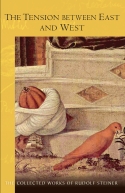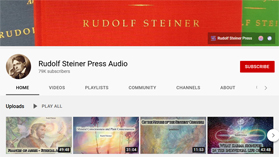
-
THE TENSION BETWEEN EAST AND WEST
Rudolf Steiner

“In ordinary consciousness, we combine our thoughts logically and thus make use of thinking to know the external sensory world. Now, however, we allow thinking to enter into a kind of musical element, but one that is undoubtedly a knowledge element; we become aware of a spiritual rhythm underlying all things; we penetrate into the world by beginning to perceive it in the spirit. From abstract, dead thinking, from mere image-thinking, our thinking becomes a thinking enlivened in itself. This is the significant transition that can be made from abstract and merely logical thinking to a living thinking about which we have the feeling it is capable of shaping a reality, just as we recognize our process of growth as a living reality.” —Rudolf Steiner
This demanding set of lectures attempts to lift the veil from modern social and spiritual problems as experienced in the contrasts between East and West. By ascribing only vague and subjective validity to human thinking, modern science tries to invalidate the very faculty that gives us our human dignity. However, such “unreality” of thought images makes possible the inner freedom that scientific doctrine tends to deny in principle. The need arises from these contradictions to extend the limits of ordinary scientific thinking toward new investigative capacities.
In part one, “Anthroposophy and the Sciences,” Rudolf Steiner explains that this can be achieved in a healthy way through two kinds of meditative exercises very different from yoga and asceticism and ancient paths to higher knowledge. These disciplines lead to the discovery of a paradoxical truth: “If you would know yourself, look into the world. If you would know the world, look into your self."
The spiritual-scientific philosophy thus presented provides a framework through which the second half of the book, “Anthroposophy and Sociology,” considers how a healthy social life can be understood and formed. Today the old social instincts of humanity have grown uncertain, and the rational intellect is proving unsuited to comprehend and foster a truly human social life. While admitting that we are only beginning to discover the right relationship between individual and community, Steiner describes how a conscious spiritual life offers the same social certainties as did the earlier, “instinctual” human life. He explains how we may find a way from our highly developed sense of a personal self toward the global social organism.
This book is a translation from German of Westliche und östliche Weltgegensätzlichkeit. Wege zu ihrer Verständigung durch Anthroposophie (GA 83, 3rd ed.), Rudolf Steiner Verlag, 1981.
26 June 2024; Trans. by B. A. Rowley; Intro. by Marie Steiner-von Sivers; (10 lectures at the Second International Congress of the Anthroposophical Movement, Vienna, June 1–12, 1922. CW 83); SB; 312pp; 23.5 x 15.2 cm; pb;
£25.00 ISBN 9781621483274

